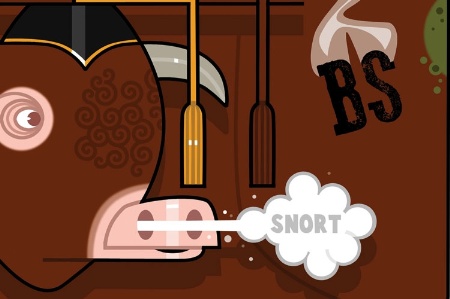Source: David Lyttleton
All one can do is quote the venality, the corrupted arguments, the bland presuppositions, and hope the somnambulist reader will wake up
The most abominable monster now threatening the intellectual health and the integrity of pure enquiry as well as conscientious teaching is the language of advertising, or better, the machinery of propaganda. Any number of critics from within university walls have warned the people at large and academics in particular of the way the helots of advertising and the state police of propaganda bloat and distort the language of thoughtful description, peddle with a confident air generalisations without substance, and serenely circulate orotund lies while ignoring their juniors’ rebuttals and abuse. It is indicative that the only street job our hapless prime minister ever had was as a public relations officer to a now-defunct television company.
Public relations is bad art as R. G. Collingwood defines bad art, which is to say deliberate self-as-well-as-other-deception and therefore “a corruption of consciousness”. The propagandist of public relations raises horrified hands at the imputation that his whole business is the concealment of hard power with soft blandishments. “An insincere mind”, Collingwood goes on remorselessly, “has no conception of sincerity.”
These dim and dark forces have beaten wide paths across the campus. The quiet-voiced managers and their amiable, gormless stooges in human resources and external relations now dominate and reshape the self-image of most universities (the exceptions are a moral lesson to us all). The rest of us, doing a proper job in physics, history, social policy, healthcare, Chinese, give the enemy a shrug and a cheery wave and get on with what has to be done. Those others may be phoney and useless, but not our business.
But of course they are, and we have come to know it. The official public speech of universities has, over a mere 30 years, become the slippery, sugared and mendacious language, pedagogically spoken only in the Schools of Business, now moving, as governments become panic-stricken about the certainty of permanent reduction in everyone’s wages except those of the filthy rich, to the very heart of the idea of a university.
This is a familiar dirge to sing, but no less mournful for that. Of course there are plenty of academics inside the walls of the City of Reason kicking up a raucous old racket of complaint against the unspeakable, but alas widely spoken, language of propaganda. We shall be applauding one such website in a moment. But there is any number of bright young Amandas and Dominics recruited into the Senate House office of identity politics with a 2:1 in PPE happily parroting the textbook jargon of the Superbrands guide.
Listen to the Superbrand channel, and to the gabble of this eager beaver of a CEO, one James Murphy (of communications agency Adam & Eve): “Brands must have a powerful point of difference, authenticity and commitment within their product and service design to be genuinely superlative. Then there’s the emotional angle – do they present themselves in a way that lives up to that?”
Ah yes, “the presentation of self”. Erving Goffman could not foresee the dreadful contamination of his ideas gathering its bulk on the other side of the historical hill.
Inside the walls, the mindless senior managers have been going – flat-out but of course calmly – for branding the old place in these representative terms commended by Durham University, no less, whose Dalek voices advise us: “Branding helps an organisation differentiate itself to target markets. It helps define an organisation in the mind of its customer. A brand is a promise to deliver a certain set of benefits, both rational and emotional. Rational beliefs conveyed through Durham University’s brand include reputation, academic excellence, research status, links with industry and employment record. Emotional benefits include location, quality of life, personality, culture and empathy.”
Just what that last drivelling sentence is supposed to mean defies the reason here so mindlessly counterposed to emotion. The readiest thing to do in reporting these detestable voices is to quote to present readers the gibberish, the clichés, the awful prose, the slipshod contentions, then to lean on the solidarity of intellectual life, and wait for laughs.
Laughter and contempt are, however, wholly ineffectual. Students are mutated into customers – a lying distortion of one of life’s crucial subordinations; disciplined enquiry is rendered smooth and shallow by that evasive noun “choice” and by the effort-free verb “deliver”.
In the face of this overwhelming advance, all one can do, once more, is quote the venality, the corrupted arguments, the bland presuppositions, and hope the somnambulist reader – geographer, linguist, administrator, engineer or metallurgist – will wake up for a moment.
“Listen,” one says desperately to him or her. “Come with me to Cardiff and just listen, if you can stand the embarrassment.” Cardiff University’s branding partner Precedent promises to: “Deliver its groundbreaking recruitment campaign from concept to delivery – including the Stephen Fry tweet-worthy Scholarship…The campaign relies heavily on email and social media marketing.”
You bet it does.
At the University of Birmingham’s branding site, its consultants – named, one assumes, by some great satirist like Jonathan Swift – Align & Pull inform us that “Birmingham had lost it’s [sic] identity”. They go on. “We were selected [in spite of our punctuation]…as a specialist with a long track record in service design, innovation and genuine brand development and thinking ]….working in partnership with Wolffolins [sic], a famous brand development agency.”

Our ancient universities, glowing with their ancientness, are perhaps the most disgusting in their slimy recipe of matey cant and trite visionary gleams
The same satirist presumably chose the name of the partners. But what kind of “genuine thinking” makes for “a long track record in innovation”, one wonders in a daze. Would we learn the answers from a PhD passed (as you might say) at the University of Portsmouth on the topic of “identifying brand values”?
No institution in this roll call of the websites is too grand or too self-confident not to genuflect before the mad marketeers. Or not until we flit across the border. Good old St Andrews, faithful to its Presbyterian heritage, will have none of it, not a glimmer of brand values.
“Heritage”, now. The very word is like a bell, resonating as the branders would certainly say, and tolling us to – where else? – the University of Cambridge. Cambridge is publisher of 63 pages of its branding policy, every one adorned with its coat of arms, synonymous, we learn, with its “identity” and “image style”. Charles Taylor, great philosopher of our day, once defined identity as that which gives each of us “our moral horizon”; “it situates us in moral space…it fixes us somewhere”. Moral space at Cambridge is less momentous. There, “image style” encourages images that “should feel observational and spontaneous…and show a contrast with our heritage – beautiful architecture and the energy of people who interact with the University”.
Heritage and spontaneity are caught, it appears, by the juxtaposition of Trinity Great Court and assorted happy and pretty young women interacting with the university by way of a book, a delightful smile, and the fan vaulting of King’s College Chapel.
Our ancient universities, glowing with their ancientness, are by this token perhaps the most disgusting of all in their slimy recipe of matey cant and trite visionary gleams. Stroll down the Strand to King’s College London and get an invitation, open to all its members, to become a “King’s Advocate”.
Thus, in an email to staff at King’s: “As part of our review of King’s Reputation and Identity, we’ve been thinking about who we are, what we stand for and what makes us special. Through an extensive process of consultation…we are forming a clear view of what makes us unique amongst universities. The next step in this process is to spread the word…we are building a team of King’s Advocates to raise awareness of where King’s is going and the importance of building a reputation that aids that journey. We hope that you will consider becoming part of this team….you will also get to meet other like-minded members of the College community and have a bit of fun along the way!
“If you are interested or would like more information, please get in touch with brand@kcl.ac.uk.”
Concealed in all this are, as one would expect, certain deadly processes. Queen Mary, University of London, for instance, is anxious to climb the irrelevant league table of universities. To do so and put a higher gloss on its brand, it is tightening up, with the spanner of redundancy, its “D3” measure, “direction × delivery × development”.
In a bitter commentary of a kind we need many more of, a subversive blog tells us that at Queen Mary, in order to justify their tenure, professors of science are required to, during the period covered by the forthcoming research excellence framework, publish with or without collaborators, 11 papers, two of them being of “high quality”, raise 400,000 quid in research money, half of which must be in their name as “principal investigator”. The data for these achievements will be “evidenced by objective metrics”. So that’s all right then.
The deathliness goes deep. At one post-1992 university, entirely representative in this but unnameable for fear of reprisal (what price academic freedom?), staff are asked to define “the University of XXX graduate”. What is needed is “a unique selling point” in relation to three or four rival institutions more or less (this being England) in the same social class. The whole undergraduate curriculum is then being rewritten to achieve – bleurgh – the envisioned “vision”, while the e-learning courses are being designed by an outside corporation.
As my informant puts it: “Obsession with standardisation is part of this – course delivery must be the same; like the parallel with customer experience, you can walk into any branch of Marks & Spencer and it feels the same; it is the same with being a student: the experience should be consistent and fit with the brand. Another effect of this ‘off the shelf’ approach to course design is the expectation – stated flatly by a member of our executive last week – that any academic should be able to teach any module on the degree programme.”
Inspiration, originality, specialist knowledge, compelling thought, and serious and bewitching manner in teaching are replaced by robotic repetition. Yet again, we must learn from Basil Bernstein, Britain’s most searching sociologist of knowledge, as he put it years ago: “Knowledge [has become] not like money, it is money…knowledge is divorced from persons, their commitments, their personal dedications…The principles of the market and its managers are more and more the managers of the policy and practices of education.”
Well, that is where we are, and “branding” is the clinching force marketising the idea of the university, reducing its life to transactions with “customers”, substituting “skills” and technique for personal knowledge (in Michael Polanyi’s necessary phrase) and gradual familiarisation with the lived principles of an exigent subject.
Standing on the edge of the plank at the very end of my career, I can’t see anything to stop the bastards now. Can you?
Discipline and flourish: how branding’s ‘radical’ questions help universities to succeed
Universities and brands. Can the two words go together? They seem like opposites: universities are institutions disinterestedly pursuing truth, and brands are gadgets designed to sell things to people. Yet almost all universities now talk the language of branding. So what’s going on?
In my working life, between London and Norwich, I straddle the two words, and the two worlds. Although I hate much of the jargon of branding – “positioning”, “differentiation”, “USP” – I believe that the discipline of branding is a good thing for any organisation.
It’s a good thing because trying to build a brand forces you to answer some fundamental “why” questions. Why should I apply to your university? Why should I work for you? Why should I fund your research? Why should I care? Why should you exist? Branding at its best is radical – it goes to the roots, and it creates change.
And the truth is that both universities and branding are changing. Universities are of course competing more than ever. Today’s (slightly unhinged) obsessionwith league tables simply shows people’s need to compare, separate and distinguish among a mass of similar-looking institutions. Students, parents, employers, academics and governments are inexorably demanding more of universities. And the digital transformation of education is only just starting. Like it or not, universities will have to explain their role, their value, to the world.
Meanwhile, branding is not what it was. It’s no longer primarily about persuasion – making people want things.
People today are well-informed, powerful and awkward, and easily decode traditional branding. They’re less “consumers” and more what the French call consommacteurs. They want to know what, in exchange for their money, time, effort and data, you will enable them to do. Many newer brands – Google, Facebook, Wikipedia – act in this way, as platforms, not as persuaders.
This could be an opportunity for universities. By answering the question “why?”, they can expand their role in the world. It won’t be easy: a true brand can’t be a centrally imposed mantra, or (at the other extreme) the bland product of consensus.
It’s not the case that every university must try to be unique – universities have too much in common. It’s more that each university should identify its ethos, its particular spirit, in order to attract the students and staff who will do best there.
Nor should universities seek to impose an ideology on their people. Instead, they should propose a starting point on which individual faculties, schools and courses can build. True, radical branding is not about standardisation and control, but about coherence and change.
The University of East Anglia, the university at which I teach, has always had “do different” as its motto, and that ethos has opened up dozens of innovations over UEA’s 50 years. Indeed, it’s partly what enabled me to get involved as a practitioner and create a pioneering course in branding.
Somewhere deep down, every good organisation has a spirit, and the real task for branding now is to use that spirit to inspire new courses, new teaching methods, new research specialisms, new joint ventures, and more: to find distinctive new ways to pursue truth and to spread understanding.
Robert Jones is head of new thinking at the branding agency Wolff Olins, and also a visiting professor at the University of East Anglia, where he helped to create the MSc brand leadership programme.
Register to continue
Why register?
- Registration is free and only takes a moment
- Once registered, you can read 3 articles a month
- Sign up for our newsletter
Subscribe
Or subscribe for unlimited access to:
- Unlimited access to news, views, insights & reviews
- Digital editions
- Digital access to THE’s university and college rankings analysis
Already registered or a current subscriber? Login



